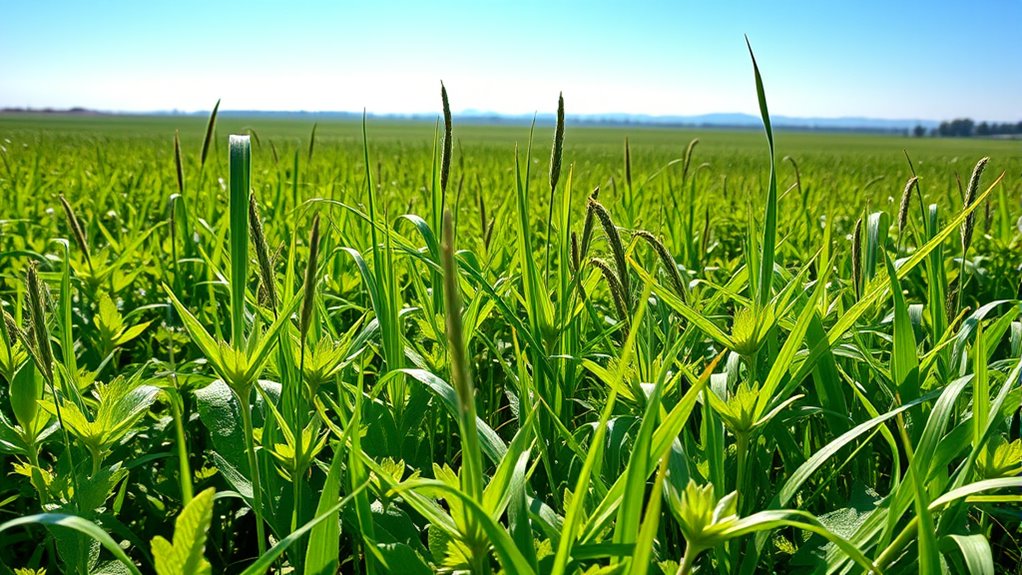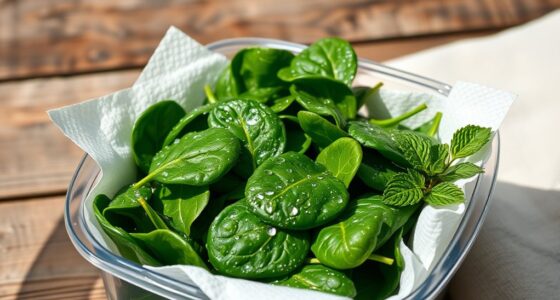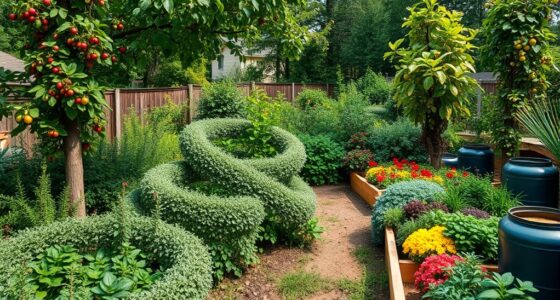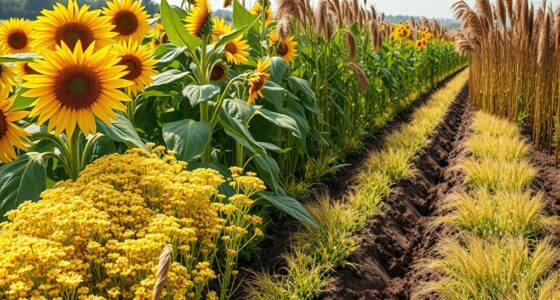For August sowing, choose fast-growing legumes like vetch or clover to enrich soil and fix nitrogen quickly. Use dense grasses or cover crops such as cereal grains to suppress weeds and prevent erosion. Consider cool-season options like winter rye, especially if your climate is cooler. Match your crop choices to your soil type and climate for the best results. Keep exploring to discover more tips for successful cover crop establishment.
Key Takeaways
- Select cover crops suited to your climate, such as winter rye, hairy vetch, or clover, for quick establishment and soil benefits.
- Aim for planting when soil temperatures are between 50-70°F to ensure optimal germination and growth.
- Incorporate legumes like vetch or clover for nitrogen fixation and soil enrichment during late summer or early fall.
- Prepare soil by testing nutrients, adding organic matter, and clearing weeds to promote healthy cover crop growth.
- Diversify cover crop mixes based on goals like erosion control, weed suppression, or soil improvement for best results.
Fast-Growing Legumes for Soil Enrichment
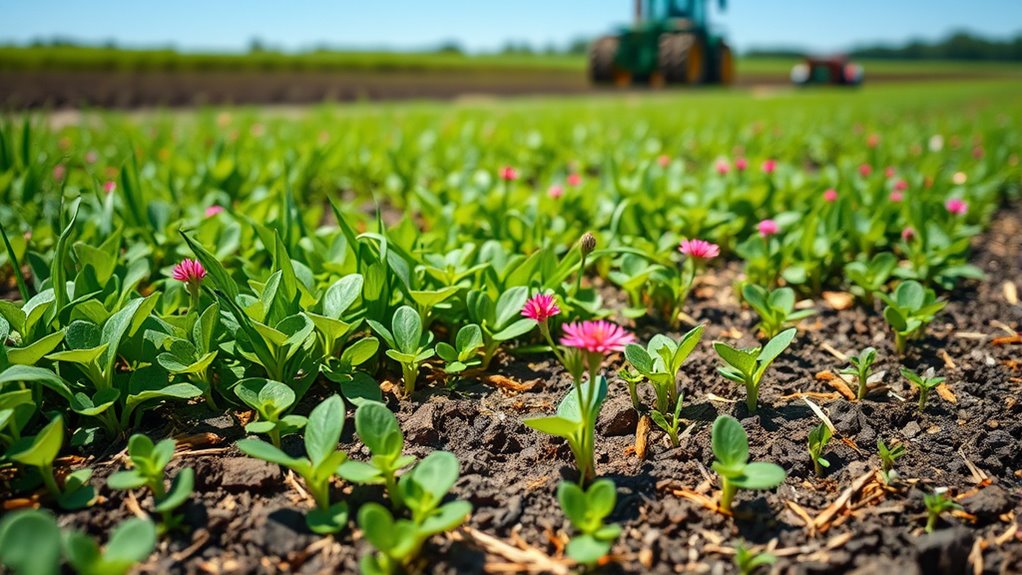
Fast-growing legumes are an excellent choice for quickly enriching your soil with nitrogen. To maximize benefits, focus on legume variety selection; choose fast-maturing, high-yielding types like clover or vetch suited for your climate. Proper planting density strategies are vital—plant too densely, and airflow suffers, increasing disease risk; too sparsely, and nitrogen fixation decreases. Aim for ideal spacing based on the species, typically around 4 to 6 inches apart. This ensures healthy growth and maximizes nitrogen fixation, boosting soil fertility. Be mindful of your soil conditions and moisture levels to support rapid germination and growth. Selecting well-adapted cover crop varieties can significantly improve success rates. Additionally, understanding soil health principles can help you tailor your cover crop choices to your specific land, enhancing overall productivity. By choosing the right legume varieties and applying effective planting density strategies, you set the stage for a productive, nitrogen-rich cover crop that benefits your garden or farm.
Cover Crops for Weed Suppression and Erosion Control

Cover crops play a crucial role in suppressing weeds and preventing soil erosion, especially on vulnerable slopes or disturbed ground. By establishing a dense canopy, they outcompete weeds for sunlight and nutrients, reducing the need for herbicides. To maximize their weed-suppressing benefits, consider applying compost to improve soil health and support vigorous growth. Healthy plants resist pests better, aiding pest management naturally. Their root systems hold soil firmly, preventing erosion during heavy rains or wind. Choose fast-growing species like cereal grains or grasses that establish quickly and form a thick cover. Properly managed, these cover crops reduce runoff, conserve moisture, and enhance soil stability. Additionally, understanding the impact of soil conditions on crop performance can help tailor cover crop choices for optimal results. Selecting cover crops based on local climate and soil type ensures better adaptation and effectiveness. Incorporating cover crop management practices such as proper seeding rates and timing can further boost their effectiveness in controlling weeds and safeguarding your soil. Implementing soil testing and analysis can provide valuable insights into nutrient needs and deficiencies, leading to more targeted cover crop selection and management. Integrating compost and pest management strategies ensures your cover crops perform at their best in controlling weeds and safeguarding your soil, and selecting species suited to your regional environment can further enhance success.
Nitrogen-Fixing Plants to Boost Soil Fertility
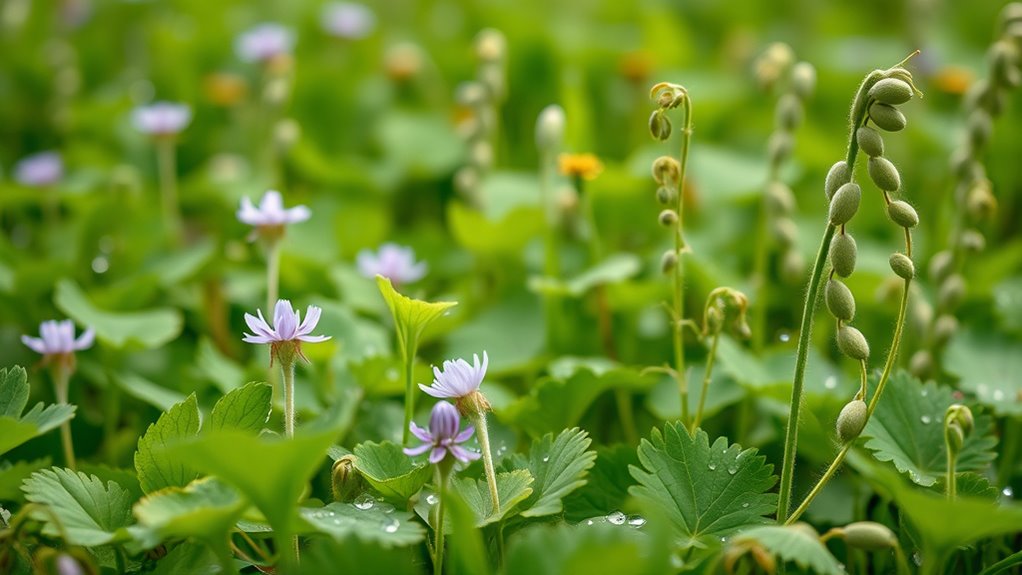
Incorporating nitrogen-fixing plants into your landscape is an effective way to naturally boost soil fertility. These plants, like clover or vetch, add essential nitrogen to the soil through symbiotic relationships with bacteria. To maximize benefits, include them in your cover crop rotation, planting them during late summer or early fall. As the growing season ends, plan for cover crop termination at the right time to prevent them from becoming weeds or competing with subsequent crops. Proper termination methods, such as mowing or tilling, help incorporate organic matter and release nutrients back into the soil. This process enriches your soil for upcoming plantings, reducing the need for synthetic fertilizers and promoting sustainable, healthy growth in your garden or farm. Recognizing the importance of professional help can further optimize your soil management strategies. Additionally, understanding the role of beneficial microorganisms in soil health can enhance the effectiveness of your cover crop practices. Incorporating practices that support soil biodiversity can further improve nutrient cycling and plant health. Engaging in composting and organic amendments further boosts soil vitality and supports microbial activity.
Cool-Season Cover Crops for Late Summer Planting

Late summer is an ideal time to plant cool-season cover crops that can improve soil health ahead of fall and winter. These crops, such as winter rye, vetch, and hairy vetch, thrive when planted in late summer, providing cover through colder months. Incorporating a diverse mix enhances cover crop diversity, which benefits soil structure and nutrient cycling. By choosing the right species, you support a balanced cover crop rotation that reduces pests and weeds while enriching the soil. Planting now helps prevent erosion and adds organic matter, setting the stage for spring planting. Understanding how content creation on platforms like TikTok influences trends can help you share your gardening journey and connect with a broader community. Utilizing soil health principles can further optimize your cover crop success and long-term farm productivity. Additionally, selecting cover crops with disease resistance traits can help ensure healthy growth throughout the season and reduce management challenges. Incorporating planting timing strategies can maximize the benefits of your late summer cover crops for upcoming planting seasons.
Selecting Cover Crops Based on Climate and Soil Type

Choosing the right cover crops depends heavily on your local climate and soil conditions. If you face cooler, wetter environments, consider hardy species that thrive in those conditions, like winter rye or hairy vetch. In warmer, drier areas, look for drought-tolerant options such as buckwheat or cowpeas. Understanding your soil type helps you select species that improve soil health; sandy soils benefit from deep-rooting legumes, while clay soils respond well to cover crops that enhance drainage. Incorporating cover crop diversity into your crop rotation strategies can help prevent pests and diseases, improve nutrient cycling, and build resilient soil. Matching cover crops to your climate and soil not only boosts their effectiveness but also ensures a successful and sustainable cover cropping system. Additionally, selecting cover crops with rustic appeal can add a charming touch to your farm or garden landscape while providing ecological benefits. Being aware of the nutrient content of different cover crops can further optimize their contribution to soil fertility and crop productivity.
Tips for Successful August Cover Crop Establishment
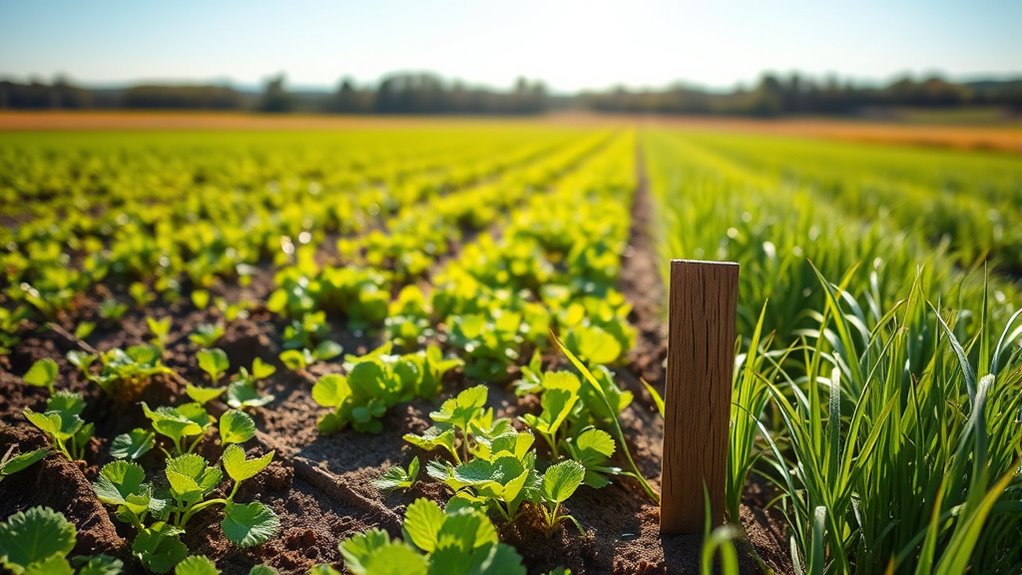
To succeed with your August cover crops, start by preparing your soil properly to guarantee good seed contact and healthy growth. Choose the right seeds based on your climate and goals, and pay attention to weather patterns to time your planting effectively. Keeping these essentials in mind will help your cover crops establish quickly and thrive through the season. Additionally, understanding signs of spoilage in related gardening practices can help ensure your seeds are fresh and viable, leading to better germination outcomes.
Soil Preparation Essentials
Preparing your soil properly is essential for a successful cover crop in August. Start by conducting a soil test to determine nutrient levels and pH, which guides your amendments. Based on the results, incorporate organic amendments like compost or well-rotted manure to enrich the soil naturally. This improves soil structure, enhances microbial activity, and provides essential nutrients for seedling establishment. You might also consider using soil conditioners to further improve soil health and structure. Consider using self-watering planters or wicking materials to help maintain consistent moisture during initial growth stages. Clear the planting area of weeds and debris, and loosen the soil to improve aeration and water infiltration. Proper soil preparation is also crucial for reducing the likelihood of clogged mechanisms and ensuring effective seed germination. Additionally, selecting the right cover crop species suited for August sowing can significantly impact your success. Implementing precision agriculture techniques can optimize seed placement and resource use, boosting your crop’s establishment. Taking these steps now boosts the chances of a healthy, vigorous cover crop that benefits your soil throughout the season.
Optimal Seed Selection
Selecting the right seeds for your August cover crop sets the foundation for successful establishment and growth. Focus on choosing seeds with proper seed treatment or seed coating to enhance germination and disease resistance. These treatments protect seeds during early growth and improve uniformity. When selecting seeds, consider variety adaptability and seed quality to ensure vigorous emergence. Use the table below to compare options:
| Cover Crop | Seed Treatment | Benefits |
|---|---|---|
| Radish | Coated | Faster germination |
| Buckwheat | Untreated | Cost-effective, easy to sow |
| Crimson Clover | Coated | Disease protection |
| Oats | Seed treatment | Improved emergence |
Opting for treated or coated seeds improves success, especially in August’s variable conditions.
Timing and Weather Tips
August is a critical time to monitor weather patterns closely, as timely conditions can make or break your cover crop success. Keep an eye on rainfall patterns; consistent moisture encourages strong germination and root development. Avoid planting during droughts or heavy rains, which can hinder establishment or cause seed washouts. Temperature fluctuations also matter—warm days promote germination, but sudden cold snaps can damage young seedlings. Aim to sow when soil temperatures are stable and warm enough for rapid growth, typically between 50-70°F. Check local forecasts regularly and plan your planting window accordingly. If rain is forecasted soon after planting, it can improve seed-to-soil contact, but too much rain may lead to waterlogging. Adjust your timing based on these weather cues for the best results.
Frequently Asked Questions
Which Cover Crops Are Most Drought-Tolerant for August Planting?
If you’re looking for drought-resistant species for August planting, you should focus on selecting resilient cover crops that thrive with minimal water. Incorporate early planting techniques to guarantee establishment before peak drought conditions. Crops like crimson clover, berseem clover, and certain small grains are known for their drought tolerance. By choosing these species and planting early, you enhance your chances of successful cover crop growth despite limited moisture.
How Do Cover Crops Impact Subsequent Crop Yields?
When you plant cover crops, they boost soil fertility by fixing nitrogen and adding organic matter, which benefits your next crop. They also control erosion by protecting the soil surface from runoff and wind. As a result, your subsequent crop yields tend to improve because the soil remains healthier and more stable. With proper cover crop management, you’ll see better crop performance and long-term soil sustainability.
Can Cover Crops Be Used in Small or Urban Gardens?
You can definitely use cover crops in small or urban gardens, even with container planting. They help improve soil health, suppress weeds, and add nutrients, making your limited space more productive. Urban gardening benefits from cover crops by enhancing soil fertility without chemical inputs. Just choose compact or fast-growing varieties suited for containers, and plant them during off-season or between main crops to maximize your garden’s potential.
What Are the Best Cover Crop Options for Shady Areas?
Imagine you have a shady backyard corner where sunlight barely reaches. You can try shade-tolerant plants like clover, which naturally fixes nitrogen, improving soil fertility. Such soil enrichment techniques enhance your garden’s health without requiring full sun. These cover crops thrive in low-light conditions, helping prevent erosion and suppress weeds, making them ideal choices for shady areas. Incorporating them supports a vibrant, productive garden even in less sunny spots.
How Do Cover Crops Affect Pest and Disease Management?
Cover crops can play a key role in pest and disease management by attracting beneficial insects that prey on pests, reducing the need for chemical controls. They also promote disease suppression by improving soil health and reducing pathogen buildup. When you plant cover crops, you’re creating a healthier environment that naturally limits pests and diseases, helping your garden stay resilient and productive without relying heavily on pesticides.
Conclusion
By choosing the right cover crops for August, you empower your soil to thrive. Focus on fast-growing legumes, lush foliage, and resilient roots to fight weeds, prevent erosion, and fuel fertility. With careful selection and confident planting, you create a resilient, revitalized landscape. Embrace this opportunity to enrich, protect, and prepare your soil—securing a strong foundation for future growth. Let your dedication deliver vibrant, verdant results, turning your field into a flourishing fortress of fertility.

